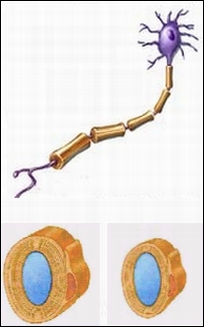
Alzheimer’s protein has important function in the healthy nervous system

Source: "picture above: dreddyclinic.com, pictures below: LMU Munich"
The main trigger of this disease is believed to be plaque-like deposits that are mainly composed of the protein amyloid beta which, in conjunction with other substances, clumps together to form hard deposits. The protein BACE 1 plays a key role in this process, since it, in conjunction with another molecular splicing agent, separates out the amyloid beta protein from a larger precursor protein.
The formation of plaques causes the death of key nerve cells and destroys the memory and other brain functions. One possible treatment approach for treating Alzheimer’s disease would therefore be the use of drugs that block the BACE 1 splicing agent, thereby preventing the formation of amyloid beta altogether.
What is unclear, however, is what side-effects may be anticipated with such an approach. Research therefore needs to be carried out into the role of the BACE 1 splicing agent in healthy humans and what consequences there would be for the intact organism if the protein were blocked.
Scientists at the National Genome Research Network (NGFN) have set themselves precisely this task and have discovered that BACE 1 is essential for the formation of the structure known as the myelin sheath. Just like an electrical cable with an insulating outer layer made from rubber or plastic, nerve fibres are surrounded by a layer of myelin. This allows the electrical impulses that nerve cells use to exchange information to be propagated smoothly and quickly along the fibres. The electrical impulses can reach peak speeds of over 400 kilometres an hour in certain situations.
The researchers on the team led by Prof. Christian Haass and Dr. Michael Willem at the Ludwig Maximilian University in Munich carried out tests on mice whose BACE1 splicing agent had been removed.In these mice, the nerves are less well-insulated and bundled together than in healthy animals.
The Munich-based researchers, working with their colleagues from the Max Dellbrück Centre in Berlin, started looking into the cause for this. They discovered that the BACE 1 splicing agent not only splices the amyloid beta precursor protein but also a further protein, neuregulin. The splicing of neuregulin causes the development of an attractant that attracts bodies known as glial cells. These wrap themselves around the nerve fibres in order to form the insulating layer.
“BACE 1 is therefore not, by its very nature, a protein that causes disease, but rather plays an important role in the human body,” says Haass. The findings highlight how careful one must be when intervening with the processes involved with the mechanisms behind Alzheimer’s disease. This is because medications that block the Alzheimer’s splicing agents might also damage the insulation of nerve fibres and thus impair the forwarding of information in the brain.
Christian Haass is optimistic, however, that it will still be possible to use such treatments. Ultimately, the nerve fibres’ insulating layer is formed during a short period after birth. By adulthood, the process is largely complete.
 Website of the scientists involved in this project
Website of the scientists involved in this project



